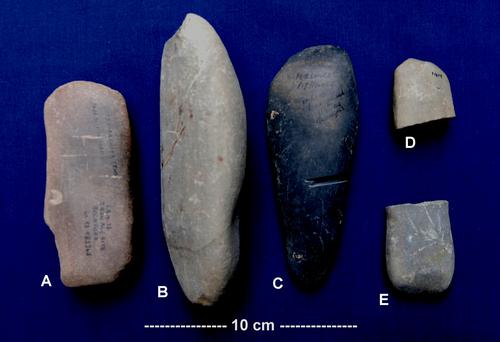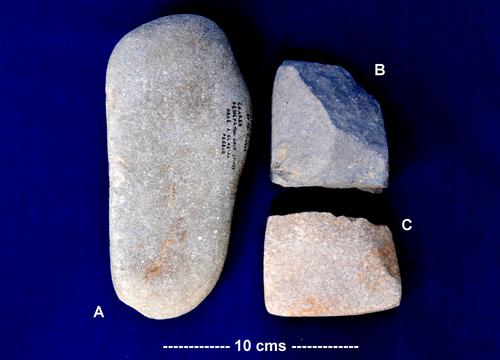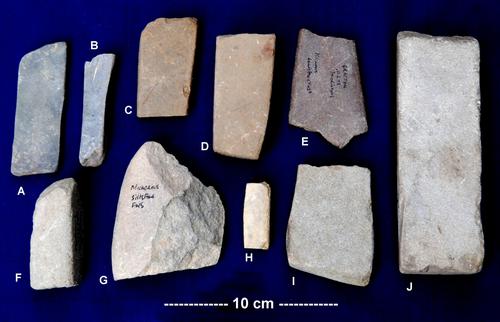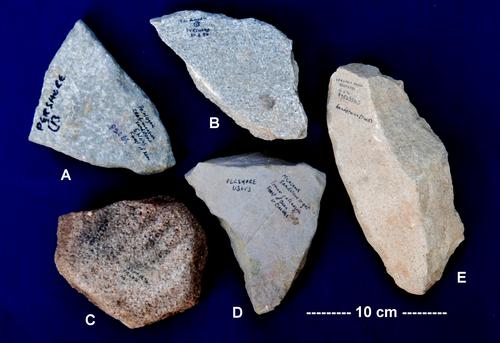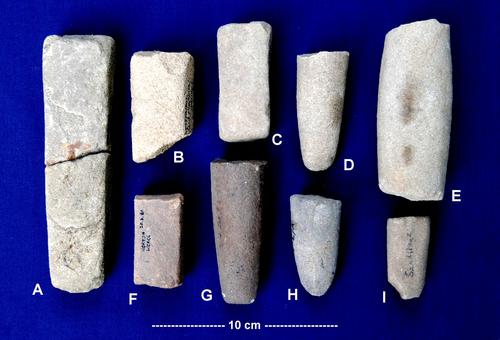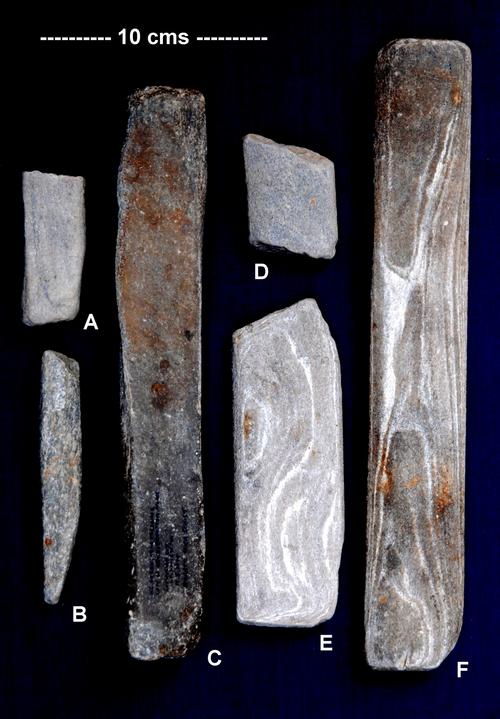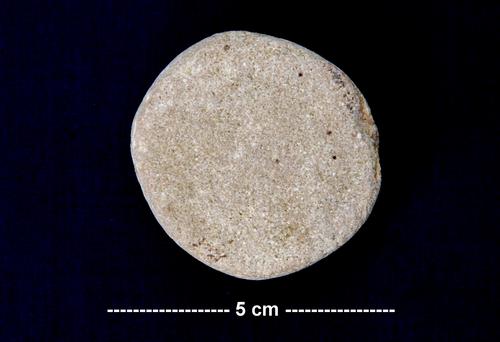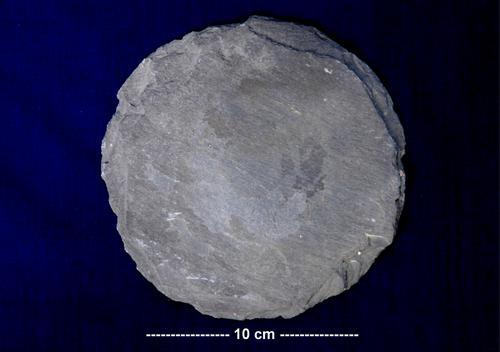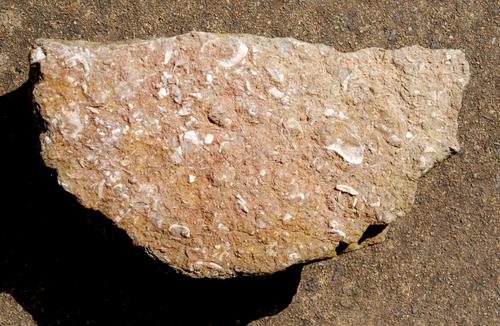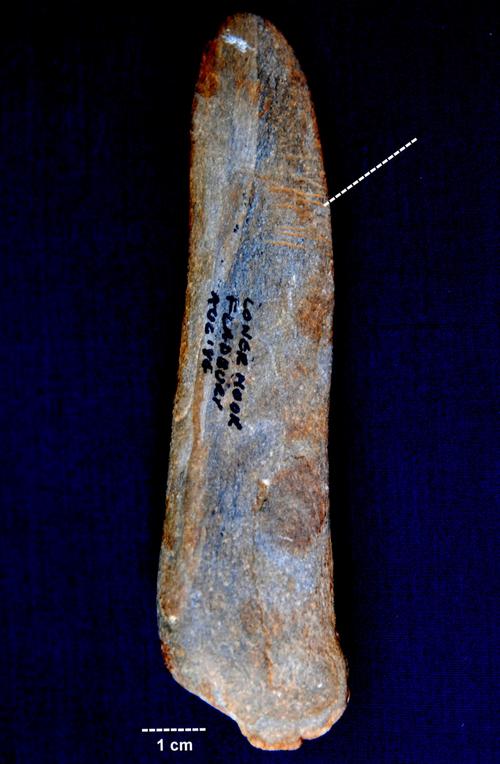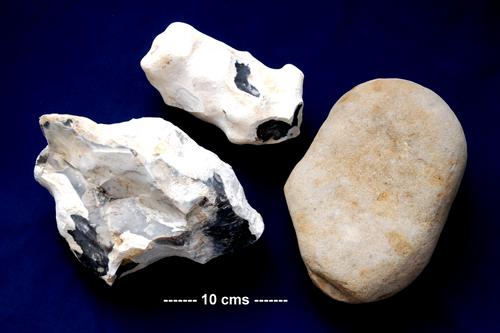A pictorial field guide to whetstones and related artefacts in Worcestershire during the past 4000 years
P.F. Whitehead
Moor Leys, Little Comberton, Pershore, Worcestershire, WR10 3EH. Email: paul@thewhiteheads.eu
Introduction
There have been many accounts of whetstones and related artefacts in local and regional archaeology (Morey & Dunham, 1953; Peacock, 1974, Dinn & Evans, 1990). Other accounts illustrate the mineralogy of rocks utilised by man (Mackenzie & Guilford, 1980) and there are broader overviews of the topic (e.g., Shackley, 1977). Useful background information can also be sourced online at http://www.englishstone.org.uk. There have been fewer pictorial studies of utilised rock from one area; that presented here should enable the interested student of such artefacts to visualise a broad typological framework thus aiding recognition. Some whetstones were valued so highly that they were handed down from one generation to another even until recently and the situation in the more distant past would have been the same. As cherished essential items (Shotton, 1968) they demonstrate the best traditions of 'sustainable society' and also lend themselves to pictorial study.
By assembling whetstones and related artefacts from and beneath land surfaces for the past 40 years, I have been able to observe resource discrimination by man, often dictated by availability and ease of access of raw materials, during the past 4000 years or so, and observe also developing patterns of trade and production technology. It will be observed amongst these abrasive artefacts that grits and sandstones are preferentially sought; it is the differential wear between quartz grains and their softer matrixes that refine the cutting edge on metal tools. Harder argillaceous siltstones and mudstones provide a more highly-resolved finish often in conjunction with the application of oil.
I have at my disposal some 60 items ranging in age from early Bronze Age to historically recent; a significant number are referred to in this account. If there is a weakness in it, it is that detailed petrographic findings cannot be included; the matching up of closely similar rocks with precise outcrops and quarries is beyond the scope of this work. Any dates given in this account should be regarded as reliable indications only, thus allowing the reader to conceive a broad chronological framework.
Early Bronze Age
A single artefact of this age is illustrated in Fig. 1 C although reference to other Bronze Age items follows later. This was previously figured by Vince and Whitehead (1978) who described it as 'unusual' and it still presents an interpretational challenge. Professor F. W. Shotton cut and examined a thin section (Fig. 1 C) and found that the rock is an indurated Palaeozoic siltstone. It was located in an infilled abandoned channel of the River Avon at Pershore some five metres below the modern land surface close to a root seam given a radiocarbon date of 3950+/-100 BP (Birm-965). Whilst some of its present shape may be natural its point and sides result from prolonged rubbing and faceting. The shape is rather unusual for a whetstone and one may speculate if this is a more specialised tool.
Iron Age to Roman
This time period accounts for all of the whetstones fashioned on glacial erratic pebbles except one (Fig. 1 E). These (Figs 1 A-E; 2 A) may also have been traded items although some will be derived in the River Severn drainage. These include metamorphic microgranites, greywacke and quartzitic sandstones from Beckford and Fladbury (not illustrated) this latter showing use as a hammerstone or pounder and weighing 800 grams. At this time traded rock appears in the form of geometric tablets and bars (Fig. 2 B, C; Fig. 3 A, C, H, I) rather than pebbles or boulders (Fig. 11). Clearly the eye was discriminating in determining subtly different rock textures for different purposes although the rocks themselves still mirror the earlier ones selected from glacial pebbles. The Roman saddle-quern rubber (Fig. 4 E) is worked on a traded 'rough-out' of Palaeozoic sandstone; eminences on the rough surface have been smoothed by the unyielding grip of its user.
Fig. 2. Roman felspathic gritstones demonstrating use of raw materials. A whetstone on a glacial erratic pebble weighing 900 grams, AD250 Carrant Valley, Kemerton SO93 11.5.1972; B snapped whetstone on traded bar, AD300 Pershore SO94 27.7.1978; C snapped rubbing stone ('reverse' view) on traded tablet, Beckford SO93 15.1.1972. P.F. Whitehead.
Medieval
Items associated with medieval landscape features or ceramic scatters, mostly thirteenth century, are few in this account but they tend to maintain earlier rock selections. They include fragmentary bars of Palaeozoic micaceous sandstones and grits (Fig. 3 E, F) and an indurated siltstone (Fig. 1 E). The infilled river channel at Pershore (Vince & Whitehead, 1978) yielded fragments of two Carboniferous non-felspathic coarse grit querns of distinct geological provenance (Fig. 4 A, B).
Post-medieval
Post-medieval (i.e. post-AD1600) sharpening stones include the well-known 'cigar stone' scythestones (Fig. 5) used by agricultural workers prior to the advent of mechanisation. These can readily be found by field-walking and those disposed of in hedge bottoms can be dated if the age of the hedge is known. A second group comprise 'bench stones' and 'pocket stones' (Fig. 6) used by craftsman such as carpenters or gardeners, in particular for grafting and budding. Scythestones were typically produced from Carboniferous micaceous sandstones. Moore (1978) recorded three sites for their production about AD1900 but Farey (1811) listed over 50 quarries that produced them prior to AD1800 showing significant variations in physical structure. Some of these sources must have been employed hundreds of years prior to that. Petrographical deductions are beyond the scope of this paper but Fig. 5 A is an intensely micaceous hone resembling those from the Yorkshire Woolley Edge Rock. The scythestones illustrated in Fig. 5 vary in their fine detail but many contain minute fragments of coal indicating their origin.
Post-medieval craftsmen's whetstones include some striking traded items, in particular metamorphic Dalradian Schists from Scotland, especially from Aberdeenshire, where the rocks were formed from Cambrian sediments. Craftsmen built up collections of these to produce a range of finishes on tempered steel blades and they were passed down through the generations. Such collections of hones received for this paper include those from the late Mr H. C. Philpotts of Lower Moor near Fladbury (Fig. 6 F together with bars of quartz mica schist and a slip of synthetic carborundum) originally belonging to his father Mr A. Philpotts who was born in 1886 in south Wales, and from the late Mr E. C. Harris of Little Comberton (Fig. 6 C, E) whose father Mr W.C. Harris was born at Charlton Kings during 1870. Both of these people were experienced plant grafters. These distinctive foliated schists with streaked out laminated minerals characterise a period of more intensive trade after AD1700 and Barrow (1904) states that they were favoured by Scottish farmers and shepherds.
The item shown in Fig. 6 D is a surface find associated with Roman ceramic so there remains the possibility that this rock was used earlier in Worcestershire. This is reinforced by its location in open-country whereas all the others are associated with 'recent' gardens and workshop activity.
Miscellaneous items
A selection of other dressed stone items are illustrated in Figs 7, 8 and 9. The function of Fig. 7 is obscure, Fig. 8 is an early post-medieval cooking pot cover and Fig. 9 may be the Roman equivalent of that; it's shelly surface is too rough for it to be regarded as a quern..
Discrimination and selection
If only one underlying principle is derived from this account it should be the unerring ability of man to discriminate between similar raw materials, now much dulled, but extending far back into prehistory. Amongst all the varieties of Carboniferous sandstone illustrated here few are identical. The Roman rubbing-stones shown in Fig. 2 C and Fig. 4 E are made from almost identical sandstones composed of tightly packed small subrounded quartz grains. The two items have thus developed a distinctive worked finish and achieved a definable desired performance anticipated in advance. In contrast the gritstone querns from medieval Pershore (Fig. 4 A B) are composed of larger angular interlocking quartz grains producing a less regular finished surface and a coarser product. These subtleties would have been understood as a matter of routine. Early on in this process, especially when selecting glacially distributed erratic pebbles, trial and error may have played a part. Fig. 10 shows a blade-like naturally cleft Palaeozoic mudstone with several cutmarks as if the finder tested it fit for purpose before discarding it. Rather similar surface marks may be created during glacial transportation and this specimen may, coincidentally, have reached Lower Moor in part by way of a glacier.
Sometime during the early Bronze Age, the fluvial regime of a Carrant Brook tributary at Kemerton changed dramatically, leading to the development of a lake. Sediments built up on the lake-bed and this continued for a long time, possibly into the medieval period. The initial phases of lake infill produced fine grey silty clays at the base of which during 1975 three significant items were found in close proximity (Fig. 11). Two of these were unused corticated high quality flint nodules quarried from the Cretaceous Chalk and certainly traded. With them was a boulder of Carboniferous felspathic grit, a rock type that does not occur naturally in the Carrant valley or even in the region providing evidence for prehistoric trade in glacially transported boulder grit. One wonders how such precious items came to be buried almost 1.3 m deep in lake sediments. Was this an accident or is it just remotely possible that these items were deliberately stored submersed in mud?
If an account such as this fails to raise questions it will not have succeeded; certainly this body of material evidence for human technology will yield a great deal more information when and if further more sophisticated research is undertaken on it.
Acknowledgements
There are too many people to thank individually for their assistance in this study. They include numerous landowners and quarry operatives who are I thank collectively. I recall with both affection and esteem the late Professor F.W. Shotton M.B.E., F.R.S. and I am grateful to Mr & Mrs H.C. Philpotts and Mr and Mrs E.C. Harris for entrusting me with their family's collections of hones. I thank Evesham Almonry Museum for accepting these artefacts for permanent curation and ongoing study.
References
Barrow, 1904. On the Moine Gneisses of the east central Highlands and their position in the Highland sequence. Quarterly Journal of the Geological Society of London 60:400-449.
Dinn, J. & Evans, J. 1990. Aston Mill Farm, Kemerton: excavations of a ring-ditch, middle Iron Age enclosures, and a Grubenhaus. Transactions of the Worcestershire Archaeological Society 12:5-66.
Farey, J. 1811. General view of the agriculture and minerals of Derbyshire 1:435-440. London: the Board of Agriculture.
MacKenzie W.S. & Guilford C. 1980. Atlas of rock-forming minerals in thin section. pp.1-98. Wiley.
Moore, D.T. 1978. The petrography and archaeology of English honestones. Journal of archaeological science 5:61-73.
Morey J.E. & Dunham, K.C. 1953. A petrographical study of medieval hones from Yorkshire. Proceedings of the Yorkshire Geological Society 29:141-148.
Peacock, D.P.S., 1974. Report on geological samples In: Oswald, A., Excavations at Beckford. Transactions of the Worcestershire Archaeological Society 3:15.
Shackley, M. 1977. Rocks and man. pp. 1-158. George Allen & Unwin Ltd.
Shotton, F.W. 1968. Prehistoric man's use of stone in Britain. Proceedings of the Geologist's Association 79:477-491.
Vince, A.G. & Whitehead, P.F., 1978. An abandoned Flandrian river channel at Pershore: startigraphy pottery and biota. Vale of Evesham Historical Society Research Papers 7:9-24.
Images
Fig. 01. Whetstones worked on glacial erratic pebbles. A Microgranite (heated as a 'boiling stone'), Iron Age, Beckford, SO93 28.4.1973; B Palaeozoic quartzitic sandstone, Roman, Little Comberton SO94 19.4.1973; C indurated Palaeozoic siltstone, Bronze Age, Pershore SO94 27.7.1978 (?specialised artefact); D Greywacke Sandstone, early Iron Age, Beckford 19.1.1973; E Palaeozoic siltstone, medieval AD1250 Broadway SP03 14.4.1982. P.F. Whitehead.
Fig. 02. Roman felspathic gritstones demonstrating use of raw materials. A whetstone on a glacial erratic pebble weighing 900 grams, AD250 Carrant Valley, Kemerton SO93 11.5.1972; B snapped whetstone on traded bar, AD300 Pershore SO94 27.7.1978; C snapped rubbing stone ('reverse' view) on traded tablet, Beckford SO93 15.1.1972. P.F. Whitehead.
Fig. 03. Roman, medieval and post-medieval whetstones and rubbing stone (G) worked on tablets and bars. A Palaeozoic micaceous siltstone, Roman, Little Comberton SO94 10.2.1976; B Palaeozoic micaceous siltstone, post-medieval, Upton Snodsbury SO95 9.5.1986; C micaceous muddy siltstone, Roman, Kemerton SO93 15.1.1980; D muddy siltstone thick snapped geometric bar, post-medieval AD1820 Little Comberton 3.9.1989; E micaceous sandstone (split bar), medieval, Grafton SO93 11.5.1975; F Carboniferous micaceous sandstone bar fragment medieval AD1250, Dumbleton SP03 15.6.1975; G Palaeozoic coarse micaceous siltstone shattered rubber, Roman, Little Comberton 2.9.1975; H Mesozoic (Jurassic) siltstone, Roman, Little Comberton 15.10.1976; I micaceous sandstone tablet, Iron Age/Roman, Beckford SO93 28.3.1976; J micaceous sandstone, post-medieval, recent, Westmancote SO93 15.9.2001. P.F. Whitehead.
Fig. 04. Roman and medieval querns and rubbing stones. A Carboniferous micaceous non-felspathic sandstone rotary quern fragment, medieval cAD1250 Pershore SO94 27.7.1978 B Carboniferous coarse non-felspathic grit rotary quern fragment medieval cAD1250 Pershore 30.6.1980; C Millstone Grit rubbing stone recycled from rotary quern, Roman, Kemerton SO93 19.5.1972; D Lower Palaeozoic Forest of
Fig. 05. Post-medieval Carboniferous bars (A, B, C, F) and cylindrical 'cigar stone' (D, E, G, H, I) scythestone fragments dating from circa AD1750 to AD1950. A micaceous felspathic grit, Broughton Gifford (Wiltshire) ST36 10.6.1980; B micaceous felspathic grit slightly subovoid in section, no data, Worcestershire; C micaceous grit, Little Comberton SO94 10.2.1979; D micaceous sandstone, Little Comberton 12.7.1982; E fine micaceous grit, Little Comberton 3.1980; F micaceous sandstone, AD1890, Norton SO85 20.2.1981; G micaceous sandstone, Pershore SO94 12.7.1978; H micaceous sandstone, Pershore, 12.7.1978; I micaceous sandstone, Broadway SP13 20.4.1976. P.F. Whitehead.
Fig. 06. Schistose whetstones. A Quartz mica schist bar fragment, AD1750 Ashton-under-hill SO93 10.5.1996; B Quartzose schist pocket hone AD1750, Wick SO94 19.7.1972; C Quartz mica schist bar heavily worked, Bricklehampton ex. Charlton Kings (Gloucestershire) AD1890 SO94 ; D Quartz mica schist bar fragment, Fladbury land surface with Roman ceramic SO94 3.2.1981; E foliated Dalradian Schist bar heavily worked, Bricklehampton ex. Charlton Kings AD1890; F foliated Dalradian Schist bar, Lower Moor ex south Wales, AD1900. P.F. Whitehead.
Fig. 07. Mesozoic Oolitic Limestone disc, Roman AD300, Little Comberton SO 94 15.6.1996. © P.F. Whitehead.
Fig. 08. Trimmed slate cooking pot cover 6 mm thick ?AD1700, Stanton (Gloucestershire) SP03 12.7.1977. P.F. Whitehead.
Fig. 09. Broken disc of fire-burnt Oolitic Limestone ?cooking pot cover 48mm thick, Roman AD300, Little Comberton SO94 27.5.2011. © P.F. Whitehead.
Fig. 10. Naturally cleft blade-like Palaeozoic micaceous mudstone, field surface amongst Roman ceramic scatter, Lower Moor SO94 18.8.1984. The pointer marks surface grooves. P.F. Whitehead.
Fig. 11. Mined corticated unstruck Cretaceous Chalk flint nodules and smoothed but apparently unused felspathic grit boulder, traded items from early Bronze Age (>BC1440) lake sediments, Kemerton SO 93 15 May 1975. P.F. Whitehead
